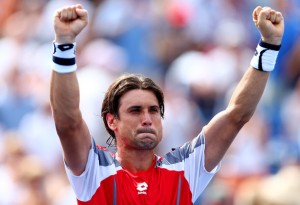US Open, Day Seven
It has occurred to me, belatedly, that my proposal to have the opening round of the US Open extended to five days carries with it a number of previously unexplored (yet important) advantages, and that highlighting these in my original submission to the USTA would have only strengthened my case. A missed opportunity, to be sure. One I rue.
Firstly, a five day opener would spread the matches out more evenly across each day, which would in turn confer several benefits: the tournament would require fewer courts – meaning some could be converted into something useful, like merchandise stalls or a roller disco – and it would permit more of the top players to play their initial rounds in the main stadium at night, thereby ensuring that fewer Arthur Ashe ticket-holders are forced to endure a remotely competitive match. Secondly, it would mean that any player who survived through the first couple of rounds would therefore feature in the second week. Seneca helpfully taught us that Majors cannot be won in the first week, only lost, a lesson that Pete Sampras famously reiterated.  It therefore seems like a net benefit to have more competitors survive this ordeal, even though the US Open’s now-established custom of Monday finals means that no one can win it in the second week either.
It therefore seems like a net benefit to have more competitors survive this ordeal, even though the US Open’s now-established custom of Monday finals means that no one can win it in the second week either.
Earlier on US Open Radio, there was some discussion of precisely what making it to the second week actually entails. It is something the players talk about all the time, and the hushed reverence of their tone suggests it means more than simply remaining active in the tournament after the first Sunday ends. Nevertheless the definition remains slippery. For half the women, reaching the second week means they’ve made it to the quarterfinals, which is indeed something to be proud of. The other half remains stranded in the fourth round, which is where the surviving men also reside, apart from John Isner and Philipp Kohlschreiber, who as I write are yet to complete their third round match.†It’s all very confusing. Wimbledon avoids this issue by having a rest day on the middle Sunday, and by having it rain a lot on the other days. The USTA is busily implementing the second of these measures. The remnants of Hurricane Irene are even now straggling up the Eastern Seaboard. The best predictions are that they will arrive by Tuesday, and then settle in like a disgraced uncle with nowhere else to be, who just will not take the hint to leave, even when you pack his bags for him, and point out that those bed sores might clear up if he would only get out of your favourite armchair.
(5) Ferrer d. (WC) Hewitt, 7/6 4/6 6/3 6/0
Lleyton Hewitt will not feature in the second week, having fallen late in the first week to David Ferrer. Hewitt failed to win a game in the last set, yet competed with enough gusto that we may regard his defeat as gallant, in contrast to Bernard Tomic several days ago, who pulled off the same feat but suffered immediate crucifixion. Not all bagels are created equal. I think Orwell said something about this. (I will resist the opportunity to extend this metaphor, for any number of reasons, but mainly because I’m not especially solid on how bagels are made – I know they’re boiled, but whenever I boil bread the result is quite disappointing – and it would just take up room. Much like this aside has.)  The truth is that Hewitt is congenitally incapable of a performance as insipid as Tomic’s against Andy Roddick, regardless of which explanation for Tomic’s performance we accept. I doubt Hewitt has ever been stage-struck, and I cannot imagine he has ever tanked a set. It’s rare for him to throw away a point, although he is not above blowing some very important ones.
The truth is that Hewitt is congenitally incapable of a performance as insipid as Tomic’s against Andy Roddick, regardless of which explanation for Tomic’s performance we accept. I doubt Hewitt has ever been stage-struck, and I cannot imagine he has ever tanked a set. It’s rare for him to throw away a point, although he is not above blowing some very important ones.
Indeed, this is an important point to bear in mind about Hewitt. Despite his hard-won reputation as the sport’s scrappiest scrapper, Hewitt does have a tendency to grow careless with leads, and he can generally be relied upon to make his own life harder if given the opportunity. For a while some felt that he was only comfortable with his back to the wall, and would therefore retreat until he felt the kiss of the brickwork against his shoulder blades. Only then could his fighting instincts kick in. Certainly more of his matches have devolved into life and death tussles than seemed strictly necessary. This was the case even during his extended sojourn atop the rankings – a nearly forgotten 80 weeks, now an eternal decade past – but has only grown more definitive in his career’s endless twilight, at least in those rare periods when he ventures away from the operating table. It was especially evident today during the first set tiebreaker, when he led Ferrer 6-3, and in total failed to take any of five set points.
It’s worth bearing mind that Ferrer is himself not an especially strong tiebreak player, although his record this year is considerably better than any other year (15-9), and well above his career average, which is decidedly average (106-102). The Spaniard’s reputation as a fighter is as justified as Hewitt’s, but contrary to popular belief neither man represents the ne plus ultra in mental composure. They fight because they must, because fighting is preferable to Tomic’s alternative, but both are still obliged to fight far more often than they should. Then again, Hewitt has the excuse that he’s no longer the player he was, while Ferrer is the world number five, and needs make no excuses to anyone.
There was a time when Hewitt might have outlasted Ferrer, but it was long ago. Ornery attrition wasn’t likely to prove a winning tactic today, especially after a prolonged five-setter against Gilles Muller two days earlier. Having correctly surmised that it was all or nothing, Hewitt set about giving it everything. Suddenly bold, he stepped into the court and hustled Ferrer off it, earning a coveted break early on then hoarding it until the end. This gave his fans another excuse to lament those squandered first set points, but I doubt even a two set lead would have done more than prolong the eventual outcome. Naturally anything can happen in sport, but there was still a firm sense that Ferrer would run him down no matter how long it took. The Australian was once the fittest man in the sport, but not anymore. The spirit remains staunch, but the flesh has parted too often beneath the surgeon’s knife, and suffered too much rehabilitation and mortification still to comply with its master’s will. Conversely, while there were times in his peak years when Hewitt might sustain reckless offence for an entire match – one truly outrageous defeat of Gustavo Kuerten in Florianopolis leaps to mind – they were frankly rare even then. Now he just can’t keep it up, a problem that often comes with age. Then again, Ferrer is almost the same age, and looked like he could go all day.
Even as the second set sloughed away, Ferrer could see that the Australian was close to spent. He has built a career on noting these moments, and then prolonging them until his opponents expire. The momentum shift in the third set was irresistible. Now the Spaniard was deciding how each point should proceed. By the fourth set the result was truly foregone. And then Hewitt was gone: 6/0, a fighting bagel. I still have no idea how they’re made, but I do know they take at least a decade to prepare.
David Ferrer, officially, has entered the second week.
†Kohlschreiber ended up defeating Isner in five sets, at 2:26am local time. Isner therefore technically enjoyed a brief stint in the second week, the definition of which grows ever more fluid.

2 Responses to The Second Week